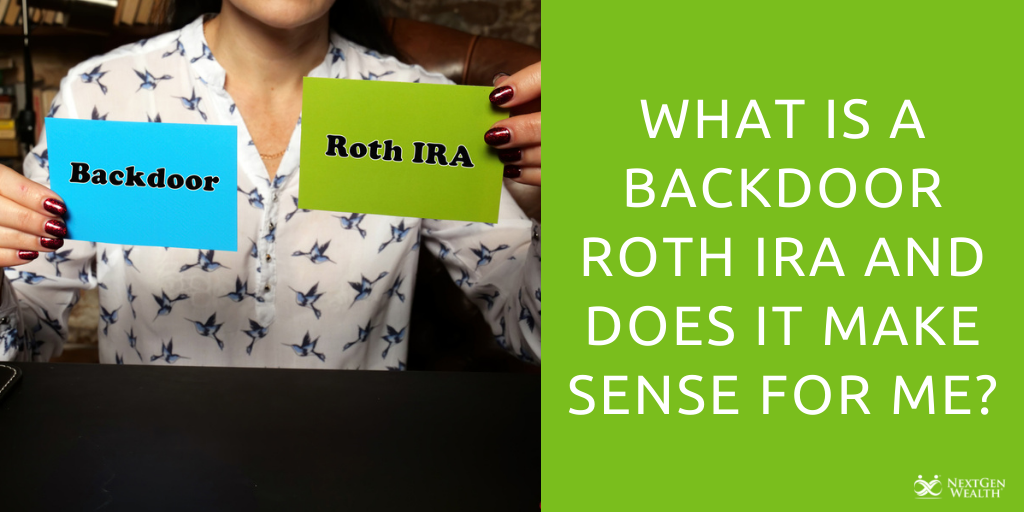What is a Backdoor Roth IRA and Does It Make Sense for Me?
Roth IRAs are one of the most fruitful investment accounts for people trying to develop a healthy nest egg. Among their numerous benefits, the tax-free growth and retirement distributions with Roth IRAs can set you up for maximum retirement earnings. 
Unfortunately, high-income earners are generally barred from taking advantage of a Roth IRA. In 2020, single earners with an annual income exceeding $139,000 were limited to a traditional IRA only.
If you have been thinking about maximizing your retirement savings but are concerned about your earnings restrictions, there is good news — you can still enjoy the myriad benefits of a Roth IRA even if you exceed the income limits. With some savvy investing, high-income earners can take advantage of the backdoor Roth IRA.
What Is a Backdoor Roth IRA?
A backdoor Roth IRA is not a standalone investment account but rather a tactic to sidestep IRS stipulations. With this method, all or part of a traditional IRA is converted into a Roth IRA. By doing it this way, you can avoid both the income limits and contribution limits, which were set at $6,000 for 2021.
How Does a Backdoor Roth IRA Work?
The IRS rules for converting a traditional IRA via a backdoor Roth IRA details three techniques:
- IRA to Roth IRA rollover: You can take a traditional IRA distribution and move it to a Roth IRA, which must be done within 60 days of taking the distribution.
- Trustee-to-trustee transfer: Your IRA custodian, per your direction, can transfer funds directly to a Roth IRA at another custodian.
- Same-trustee transfer: If your traditional and Roth IRAs are serviced by the same cusotidan, you can transfer between accounts.
Transfers are the least risky because they do not have inherent deadlines and fees. If you do not roll over the funds within the 60-day window, you may face a 10 percent tax penalty.
Backdoor Roths and Taxes
A backdoor Roth IRA does not allow you to avoid your tax liability. After-tax dollars go into Roth IRAs, but pre-tax money goes into traditional IRAs. As a result, if you deduct traditional IRA contributions, you will need to pay those back when you roll the funds over to the Roth IRA. On top of that, any accumulated earnings on the amount you transfer will also be taxed.
Contributions to a Roth IRA also count as income because they are being withdrawn from a traditional IRA, so be mindful of how much you take out. If you convert too much, you may be pushed into a higher tax bracket for the year.
Traditional IRAs and the Pro-Rata Rule
A pro-rata rule is a crucial consideration when it comes time to determine your annual tax bill. In backdoor Roth IRA conversions, the manner in which the IRS views your IRAs can affect how much you pay.
Traditional IRAs are viewed as a single account by the IRS. This means that you cannot specifically pick your post-tax contributions to be moved over to avoid additional costs.
Let’s say that 70 percent of your aggregate IRA funds earned deductions and 30 percent did not. The IRS will view any disbursement as having a 70 percent tax liability. No matter how much you convert to a Roth IRA or which traditional account you pull it from, you will face the same tax liability.
The pro-rata rule can have heavy implications on your year-end tax bill. Furthermore, state governments can apply their own tax rules to backdoor Roths, which only complicates matters even more.
If you are considering a backdoor Roth IRA, it is crucial to speak with a financial advisor that can help you maximize your contributions and minimize your tax responsibility.
Backdoor Roth IRAs: The Step-By-Step Process
Open a Traditional IRA
To get to a Roth IRA if you are a high-income earner, you need to start with a traditional IRA. You can contribute to a pre-existing IRA, though bear in mind that the previous funds may affect taxes due to the aforementioned pro-rata rule.
If this is a new account, try to find a provider that can manage both your traditional and eventual Roth IRA for simplicity’s sake down the line.
To help you at year's end, be sure to fund your new IRA with nondeductible contributions, which may be automatic if you are already a high-income earner. You will need to file IRS Form 8606 detailing those contributions when you do your taxes.
One neat “trick” to reducing your tax liability from the pro-rata calculation is to reduce your pre-existing IRA funds. This can be done by moving your untaxed IRA dollars into a current employer’s 401(k), most of which are not subject to the pro-rata rule. Employers manage this in different ways, so it is important to talk to your payroll department to start the process.
Talk to Your IRA Providers and Convert from a Traditional to a Roth
Reach out to your IRA servicers after establishing your traditional IRA funds to get the necessary conversion paperwork. No matter how you set it up, a same-trustee or trustee-to-trustee transfer will be the safest and most convenient method.
If your provider cannot coordinate a transfer, they can cut you a check for you to deposit yourself. It is crucial to do this within the 60-day window so that the IRS does not view it as an early IRA withdrawal, which would be subject to penalties.
Because IRAs are viewed as an aggregate when you do a backdoor Roth IRA, earnings add to the pre-tax amount. When you do your conversion, those earnings will be taxed. This is why you need to convert your traditional IRA to a Roth immediately after funding it, so there will be no gains to tax.
Pay Your Taxes
As a general rule, the contributions going into your backdoor Roth IRA that have not been taxed yet will be taxed. This includes any earnings that accumulated in the traditional IRA and any pre-tax funds, which factor into your annual total via the pro-rata rule. And be prepared for additional income tax burdens, especially if you fail to follow the 60-day guideline.
Why Should I Consider a Backdoor Roth?
High earners have plenty of reasons to pursue a backdoor Roth IRA. These accounts can accomplish numerous retirement goals due to their growth potential and lack of traditional restrictions.
Let’s look at the key benefits of a Roth IRA to see why you should consider a backdoor contribution over a traditional IRA.
Tax-Free Withdrawals
Traditional IRAs have tax-deudctible contributions, which is great when you want to immediately save on your annual tax bill. However, when you enter retirement, any distributions will need to be taxed under normal income tax rules.
All things being equal, taxation like this from a traditional IRA could result in more costs to you than a Roth IRA. Since earnings generate over time, taking those as part of your disbursements from a traditional IRA will mean they are taxed as part of your income. With a Roth IRA, your contribution will be taxed but your distribution will not.
Fewer Distribution Requirements
Unlike 401(k)s and traditional IRAs, Roth IRAs are not subject to required minimum distribution (RMD) rules. RMDs ensure that the IRS gets their due taxes from previously untaxed funds. When you reach age 73, you have to take regular distributions from accounts so that those funds can be taxed.
RMD rules are fine to manage if you only plan to use your investments for yourself in retirement. For those who want to leave the best inheritance for their heirs, however, RMDs can seriously diminish that effort.
Individuals with Roth IRAs can keep them in place to pass on to their heirs. As a bonus, the tax-advantaged distributions also extend to beneficiaries, so they can receive the funds in full. Heirs will be subject to the five-year waiting period, however, which will be discussed later.
Unimpeded Earnings
RMDs can stifle your growth efforts for two reasons:
- They take away from funds that can accumulate further earnings.
- They force distributions even if market conditions are less than favorable. Cashing out could equal assets being sold at a loss.
With a Roth IRA, you can leave your funds to grow tax-free as long as you want. And when you do want to take a distribution, you can wait for good market conditions that maximize your savings.
Early Access to Money
If you are under the age of 60, putting money into a Roth IRA can help you with unexpected financial burdens for the immediate future.
Roth IRAs allow for qualified distributions, meaning that you can make withdrawals at any time without paying any taxes or penalties. The catch is that the amount cannot exceed what you contributed. If you take out any of your accumulated earnings before you turn age 59½, those funds will be taxed and subject to a 10 percent penalty.
Special Considerations
The 5-Year Rule(s)
A backdoor Roth IRA needs careful planning because they are subject to both a standard five-year Roth IRA rule and one for backdoor conversions.
First, although you can take distributions at any time, you have to wait until after you turn 59½ to withdraw earnings without penalties. Additionally, no matter how old you are, you have to wait at least five years after your first Roth IRA contribution to take out any additional earnings.
This five-year waiting period applies for any earnings distribution, but there are two instances where account holders do not have to wait until they turn age 59½ to get penalty-free withdrawals:
- They are using the distribution, up to $10,000, toward purchasing their first home.
- The account holder becomes disabled.
The second five-year rule applies to traditional IRA to Roth conversions. Because they are not categorized as contributions, every conversion to a Roth IRA will begin a new five-year period. This means that those funds will not be available without penalties until after you make the conversion.
Let’s say you convert $5,000 in a traditional IRA to a Roth IRA in 2019. Then, in 2020, you convert another $5,000. In 2024, you will only be able to access the original $5,000 tax and penalty-free.
Summary: Who Benefits from a Backdoor Roth IRA?
As you can see from the growth potential and flexibility in withdrawals, backdoor Roth IRAs can be highly beneficial for high earners who normally would not qualify. If you can manage the upfront fees, Roth IRA conversions can provide untaxed growth, zero RMD stipulations, and a potentially large inheritance for your heirs.
A backdoor Roth IRA may be an excellent option for you if the following apply:
- You plan on being in a higher tax bracket after you retire. If you have a low-income period, perhaps caused by COVID, a conversion may not be subject to as much tax as retirement income.
- You can make a conversion without being pushed into a higher tax bracket.
- You can manage the potentially large tax burden without dipping into your IRA withdrawal, which would incur the 10 percent penalty if you are under age 59½.
- You will not need the converted money in the next five years. This goes for every conversion, not just the first. If you have to do an early withdrawal of any earnings, you will be subject to the extra taxes and penalties.
Talk to a Financial Advisor About a Backdoor Roth IRA
Deciding whether a backdoor Roth IRA makes sense for you starts with understanding your retirement goals and tax situation, both in the present and in retirement. When you start considering pro-rata taxation, distribution penalties, and the various impactful nuances of backdoor Roth IRAs, the process can get pretty complicated.
Talking to an experienced financial advisor is the first step toward maximizing your wealth. When you partner with NextGen Wealth, you receive a personalized experience that connects you with investment solutions to meet your short and long-term goals. Get started with a free financial assessment or contact us for more information on how we can help you build the best retirement plan.



